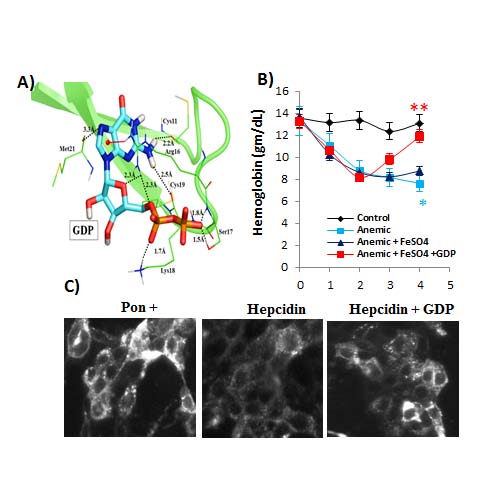IDENTIFICATION OF GUANOSINE 5ʹ-DIPHOSPHATE AS POTENTIAL IRON MOBILIZER: PREVENTING THE HEPCIDIN-FERROPORTIN INTERACTION AND MODULATING THE INTERLEUKIN-6/STAT-3 PATHWAY
(Abstract release date: 05/18/17)
EHA Library. angmo S. 06/25/17; 182097; S810

Stanzin angmo
Contributions
Contributions
Abstract
Abstract: S810
Type: Oral Presentation
Presentation during EHA22: On Sunday, June 25, 2017 from 08:15 - 08:30
Location: Room N109
Background
Anemia of inflammation (AI) is one of the most common manifestations of iron deficiency in the patients with inflammatory conditions. AI is responsible for hypoferremia, with consequent iron-restricted erythropoiesis with high level of hepcidin, which stimulate the internalization of ferroportin (FPN) transporter. Therefore, inhibiting hepcidin-mediated FPN degradation can be an important strategy to ameliorate AI.
Aims
To increase iron bioavaibility we selected a Novel compound against hepcidin action through natural compound libraries that might provide a new alternative approach to increase iron absorption for prevention of hepcidin-mediated FPN internalization and to ameliorate turpentine-induced anemic state with different insilico, invitro and invivo studies.
Methods
A systematic approach involving in silico, in vitro and in vivo studies was employed to identify hepcidin inhibiting agents. To identify a potent hepcidin-binding agent, natural compounds were screened using molecular docking and dynamics simulations and further investigated on cell lines (GFP-FPN, Caco-2, HepG2) using flow cytometry and western blotting. Normal or turpentine induced anemic mice were used in the associated studies.
Results
The virtual screening via molecular modelling showed that GDP as a potent hepcidin-binding agent as shown in the (Figure 1A). In vitro studies revealed that GDP significantly increased ferroportin stabilization in GFP-FPN cell lines (Figure 1C) and In vivo results showed that co-administration of GDP and ferrous sulphate (FeSO4) significantly improved the turpentine-induced anemic state with increase in haemoglobin level (Figure 1B).

Conclusion
AI is a normocytic anemia, common among patients with chronic infection and inflammatory disorders. We found that GDP molecule have higher contribution to the stability of hepcidin-GDP complex and thus blocks its interaction with FPN. The results support the novel hypothesis that GDP along with iron supplement regime can overcome the binding of hepcidin from interaction with FPN that would be an effective treatment for AI.
Session topic: 28. Iron metabolism, deficiency and overload
Abstract: S810
Type: Oral Presentation
Presentation during EHA22: On Sunday, June 25, 2017 from 08:15 - 08:30
Location: Room N109
Background
Anemia of inflammation (AI) is one of the most common manifestations of iron deficiency in the patients with inflammatory conditions. AI is responsible for hypoferremia, with consequent iron-restricted erythropoiesis with high level of hepcidin, which stimulate the internalization of ferroportin (FPN) transporter. Therefore, inhibiting hepcidin-mediated FPN degradation can be an important strategy to ameliorate AI.
Aims
To increase iron bioavaibility we selected a Novel compound against hepcidin action through natural compound libraries that might provide a new alternative approach to increase iron absorption for prevention of hepcidin-mediated FPN internalization and to ameliorate turpentine-induced anemic state with different insilico, invitro and invivo studies.
Methods
A systematic approach involving in silico, in vitro and in vivo studies was employed to identify hepcidin inhibiting agents. To identify a potent hepcidin-binding agent, natural compounds were screened using molecular docking and dynamics simulations and further investigated on cell lines (GFP-FPN, Caco-2, HepG2) using flow cytometry and western blotting. Normal or turpentine induced anemic mice were used in the associated studies.
Results
The virtual screening via molecular modelling showed that GDP as a potent hepcidin-binding agent as shown in the (Figure 1A). In vitro studies revealed that GDP significantly increased ferroportin stabilization in GFP-FPN cell lines (Figure 1C) and In vivo results showed that co-administration of GDP and ferrous sulphate (FeSO4) significantly improved the turpentine-induced anemic state with increase in haemoglobin level (Figure 1B).

Conclusion
AI is a normocytic anemia, common among patients with chronic infection and inflammatory disorders. We found that GDP molecule have higher contribution to the stability of hepcidin-GDP complex and thus blocks its interaction with FPN. The results support the novel hypothesis that GDP along with iron supplement regime can overcome the binding of hepcidin from interaction with FPN that would be an effective treatment for AI.
Session topic: 28. Iron metabolism, deficiency and overload
{{ help_message }}
{{filter}}


